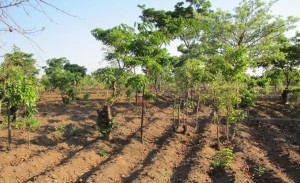 Farmer-Managed Natural Regeneration (FMNR) is the fastest-growing form of EverGreen Agriculture in Africa. It is especially popular in the drylands where droughts are frequent and intense. Because it requires minimal or no cash investment, it can expand rapidly through farmer-to-farmer and village-to-village diffusion. A dramatic case in point is Niger, where more than 5 million hectares of medium-to-high density tree cover has been regenerated on croplands over just a couple of decades (see photo). But Niger is just the tip of the iceberg. A recent study carried out in Niger, Mali, Burkina Faso, and Senegal found that almost all farmers are actively regenerating trees on their farms. FMNR is also widespread in Ethiopia and Malawi, and is now being promoted in many other countries through various initiatives and development projects.
Farmer-Managed Natural Regeneration (FMNR) is the fastest-growing form of EverGreen Agriculture in Africa. It is especially popular in the drylands where droughts are frequent and intense. Because it requires minimal or no cash investment, it can expand rapidly through farmer-to-farmer and village-to-village diffusion. A dramatic case in point is Niger, where more than 5 million hectares of medium-to-high density tree cover has been regenerated on croplands over just a couple of decades (see photo). But Niger is just the tip of the iceberg. A recent study carried out in Niger, Mali, Burkina Faso, and Senegal found that almost all farmers are actively regenerating trees on their farms. FMNR is also widespread in Ethiopia and Malawi, and is now being promoted in many other countries through various initiatives and development projects.
This phenomenon is examined in a new book just released by the World Bank that examined this trend and looked at what it means for farmers (insert web site here). More than 100 woody species are currently being managed by Sahelian farmers through natural regeneration. The benefits from FMNR vary from location to location, depending on which tree species are present in the area, and what products and services are valued locally. They contribute products for human consumption (more than $200 per household per year) which is a major part of overall income, and they provide feed for livestock during the dry season, and increase crop yields by 20-25 percent.
These tree-based systems enhance the capacity of households to cope the effects of shocks. Trees are assets that can be cut and sold for cash in times of need. In south-central Niger, where 1.2 million households now sustain many trees on their crop fields, farmers cut tree branches on a continuous cycle for household fuel wood supplies and for sale. Some mature trees are cut down and sold in local wood markets. Export markets are active in shipping wood south to Nigeria. During prolonged drought periods these tree assets may be gradually liquidated to supply the household with cash for food purchases. This process was observed to be an important source of coping capacity during recent droughts.
The accumulating evidence about the role of FMNR as a foundational practice in dryland agriculture was reviewed at the 2nd African Drylands Week Conference that was convened by the African Union. The results prompted the body to propose that the AU establish and achieve an ambitious goal to scale-up FMNR throughout the continent. The declaration recommended and proposed that:
“The drylands development community, through the African Union, and all collaborating and supporting organizations, commit seriously to achieving the goal of enabling EVERY farm family and EVERY village across the drylands of Africa to be practicing Farmer-Managed Natural Regeneration and Assisted Natural Regeneration by the year 2025.”
See: http://rea.au.int/en/content/second-africa-dry-land-week-n%E2%80%99djamena-chad
The EverGreen Agriculture Partnership is currently working with the AU Commission to develop a platform that could facilitate, support and better coordinate the many efforts at the regional, national and local levels that are now under way to realize this goal. Such a platform could inspire deeper political commitment to the goal, and provide a mechanism to underpin greater investments to accelerate the process of scaling-up.
For more background the practice of FMNR see: FMNR Hub Website and evergreenagriculture.net.
For more information and to get engaged in the initiative contact Dennis Garrity at D.Garrity@cgiar.org




